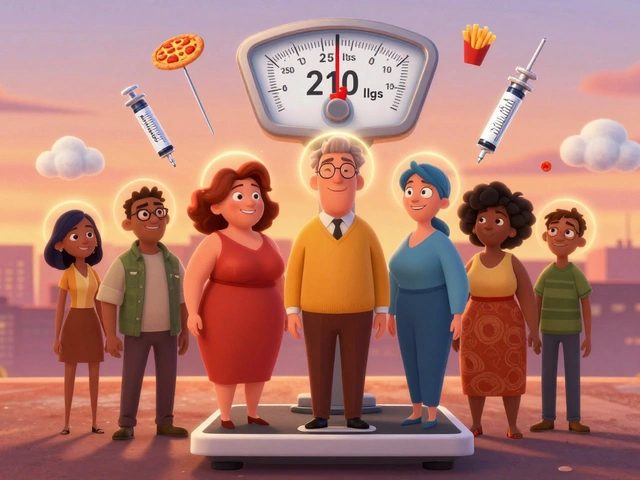Ciprofloxacin (Cipro) vs Common Alternatives: Pros, Cons, and When to Choose

Ciprofloxacin Safety & Appropriateness Checker
This tool helps clinicians or patients evaluate if Ciprofloxacin is a suitable choice based on patient age, medical history, and infection type.
Ciprofloxacin is a fluoroquinolone antibiotic that interferes with bacterial DNA gyrase, stopping replication. It’s sold under the brand name Cipro and comes in tablets, oral solution, and intravenous form. Doctors prescribe it for urinary tract infections, certain types of gastro‑intestinal infections, and some respiratory infections when other choices aren’t ideal. The drug’s broad gram‑negative coverage makes it a go‑to in emergency rooms, but the flip side is a growing list of safety warnings.
Why clinicians reach for Cipro
When a patient presents with an acute uncomplicated urinary tract infection (UTI), the Ciprofloxacin 500mg twice daily often clears the bug within 48hours. Its high oral bioavailability (≈70%) means plasma levels are similar whether taken by mouth or given IV, simplifying step‑down therapy. For travelers returning from South‑East Asia with Shigella or Campylobacter infections, Cipro’s gram‑negative potency is especially useful.
Safety profile and red‑flag warnings
Since 2016 the FDA has issued a boxed warning for all fluoroquinolones, including Cipro, about tendon rupture, peripheral neuropathy, and serious neuropsychiatric effects. The risk rises for patients over 60, those on corticosteroids, and individuals with a history of tendon disorders. Other common side effects are nausea, diarrhea, and photosensitivity. Because of these concerns, many stewardship programs now reserve Cipro for infections where no safer oral options exist.
Major alternatives to Cipro
Below are the most frequently substituted agents, each with its own spectrum, dosing, and safety notes.
- Levofloxacin - another fluoroquinolone, slightly better against atypical respiratory pathogens but shares the same class warnings.
- Azithromycin - a macrolide with good activity against many gram‑positive and atypical organisms; low tendon risk but can cause QT prolongation.
- Amoxicillin - a beta‑lactam with a narrow gram‑positive focus; safe in pregnancy and children, but many gram‑negative uropathogens are resistant.
- Doxycycline - a tetracycline that covers both gram‑positive and gram‑negative bacteria, plus atypicals; photosensitivity is the main drawback.
- Trimethoprim‑sulfamethoxazole (Bactrim) - a sulfonamide combo excellent for uncomplicated UTIs; contraindicated in severe sulfa allergy and renal impairment.

How the drugs compare
| Drug | Spectrum (Gram±) | Typical Indication | Common Dose (adult) | Major Side Effects | Regulatory Warning Level |
|---|---|---|---|---|---|
| Ciprofloxacin | Gram‑negative>Gram‑positive | UTI, gastro‑enteritis, prostatitis | 500mg PO BID | Tendon rupture, peripheral neuropathy | Boxed warning (fluoroquinolone class) |
| Levofloxacin | Gram‑negative>Gram‑positive, atypicals | Community‑acquired pneumonia | 750mg PO daily | Same as Cipro (tendon, neuropathy) | Boxed warning |
| Azithromycin | Gram‑positive, atypicals | Chlamydia, atypical pneumonia | 500mg PO daily ×3days | QT prolongation, GI upset | Warning for cardiac risk |
| Amoxicillin | Gram‑positive, limited Gram‑negative | Otitis media, sinusitis | 500mg PO TID | Allergic rash, GI upset | No major FDA warning |
| Doxycycline | Broad (Gram±, atypicals) | Rickettsial disease, acne | 100mg PO BID | Photosensitivity, esophagitis | Warning for fetal tooth staining |
| Trimethoprim‑sulfamethoxazole | Gram‑negative>Gram‑positive | Uncomplicated UTI | 800/160mg PO BID | Hyperkalemia, Stevens‑Johnson | Warning for severe skin reactions |
Choosing the right drug: decision guide
Think of antibiotic selection as a three‑step checklist:
- Identify the pathogen and site. Gram‑negative rods in the urinary tract point toward Cipro or Bactrim; atypical pneumonia pushes you to Azithromycin or Levofloxacin.
- Assess patient risk factors. Age>60, steroid use, or a history of tendon disorders tip the scale away from any fluoroquinolone.
- Balance efficacy versus safety. If a narrow‑spectrum beta‑lactam (like Amoxicillin) will work, it wins because of fewer serious warnings.
In practice, a 45‑year‑old woman with a first‑time uncomplicated UTI and no contraindications may receive a 3‑day course of Ciprofloxacin. The same infection in a 70‑year‑old man on chronic prednisone would be better served with Trimethoprim‑sulfamethoxazole, provided the local resistance pattern is acceptable.
Related concepts you’ll encounter
Understanding antibiotic resistance helps explain why stewardship groups are tightening Cipro use. Resistance rates for Escherichia coli to fluoroquinolones have climbed above 30% in many North American regions, making agents like Nitrofurantoin or Fosfomycin attractive first‑line options for simple UTIs.
Another umbrella term is fluoroquinolone class. All members share a core mechanism (DNA gyrase inhibition) and thus share the same FDA boxed warning. Knowing that Levofloxacin is merely a cousin of Cipro prevents you from assuming it’s “safer” when the same tendon risk applies.
Finally, pharmacokinetics of Cipro-high oral bioavailability, low protein binding, and renal excretion-makes dose adjustment essential in chronic kidney disease. Alternatives like Azithromycin have hepatic metabolism, which can be preferable when renal function is compromised.
Next steps for patients and prescribers
If you’re a patient, ask your clinician:
- “Is there a narrower‑spectrum antibiotic that will work for my infection?”
- “What are the specific side‑effect risks for my age and medical history?”
- “Do we need to adjust the dose for my kidney function?”
Prescribers should consult local antibiograms before defaulting to Cipro, document the justification for fluoroquinolone use, and schedule a follow‑up to monitor for tendon pain or neurologic symptoms.

Frequently Asked Questions
Can I use Ciprofloxacin for a sore throat?
Ciprofloxacin is not first‑line for streptococcal pharyngitis because it offers no advantage over penicillin or amoxicillin and carries higher risk of tendon injury. Reserve it only for proven bacterial infections resistant to standard agents.
Why do doctors avoid prescribing Cipro to older adults?
People over 60 have a higher incidence of tendon degeneration, and fluoroquinolones can trigger tendon rupture, especially the Achilles. The FDA boxed warning explicitly mentions this age‑related risk, so clinicians often choose safer alternatives for seniors.
Is a short course of Ciprofloxacin safer than a longer one?
Shortening therapy (e.g., 3‑day vs 7‑day) reduces overall exposure and thus the chance of side effects, while still achieving cure for many uncomplicated UTIs. However, the decision must be based on infection severity, pathogen susceptibility, and patient factors.
How does resistance to Ciprofloxacin develop?
Bacteria acquire mutations in the genes encoding DNA gyrase or topoisomerase IV, reducing drug binding. Overuse of fluoroquinolones accelerates selection of these resistant strains, which is why stewardship programs limit Cipro to cases where no equally effective, lower‑risk drug exists.
Can I take Ciprofloxacin with calcium supplements?
Yes, but separate dosing by at least two hours. Calcium can chelate fluoroquinolones in the gut, lowering absorption and potentially leading to sub‑therapeutic levels.






Jenae Bauer
September 25, 2025 AT 22:15When you stare at the endless tables of antibiotic spectra, you can't help but wonder if the pharmaco‑industry is selling us a narrative, a neat story where Cipro is the hero against gram‑negative villains, while quietly whispering about tendon ruptures in the back‑room. It's almost poetic, the way they brand it as a "broad‑spectrum savior" yet hide the boxed warning behind fine print that most patients never read. The safety profile reads like a government conspiracy, a list of side effects curated to scare the public just enough to keep them dependent on newer, patented drugs. And here we are, trusting a molecule that was discovered in the 80s, while the same labs push out novel quinolones every year, claiming they are safer. Meanwhile, the resistance numbers climb like a silent rebellion, a reminder that our choices are often dictated by profit rather than pure science. If you ask me, the whole Cipro debate is less about microbiology and more about who gets to control the narrative of health.
vijay sainath
September 26, 2025 AT 09:22Listen, the data doesn't need a secret society to prove it's risky – the FDA boxed warning is public, the studies are out there, and the tendon tears are documented. Your "narrative" sounds like a lazy excuse to avoid taking responsibility for prescribing patterns that still favor Cipro despite better options. The fact that many hospitals keep it on formulary is a policy failure, not a hidden agenda. If a drug causes peripheral neuropathy, the logical step is to reserve it for cases where alternatives truly fail, not to keep spamming it like a cheap meme. Stop romanticizing the conspiracy and look at the actual guidelines.
Daisy canales
September 26, 2025 AT 20:28i guess cipro is still around because doctors need a quick fix and patients want results fast but who cares about the side effects when you can get rid of an infection in two days. the alternatives are fine but sometimes they need longer courses and more pills which is a hassle.
Olivia Christensen
September 27, 2025 AT 07:35💬 totally get the frustration with the hassle, but think about the long‑term cost of tendon injuries – they’re not just a minor inconvenience. 😊 if you can spare a few extra days of a different antibiotic, you might avoid a much bigger problem down the road. plus, many of the alternatives, like nitrofurantoin for simple UTIs, have a great safety profile and work well for most patients.
Lauren W
September 27, 2025 AT 18:42Ah, the ever‑so‑convenient allure of Cipro, touted as the "Swiss‑army knife" of antibiotics, yet ignored are the myriad subtleties that render such a monolith utterly obsolete, especially when one considers the nuanced pharmacokinetic profiles, emergent resistance patterns, and the ethical ramifications of prescribing a drug with such a formidable adverse‑event spectrum; indeed, one must ask whether the stewardship committees have truly internalized the gravity of these considerations, or merely indulge in a perfunctory checklist that glorifies convenience over clinical prudence, thereby perpetuating a cycle of over‑reliance on a medication whose time‑worn efficacy is now as questionable as the motivations behind its continued promotion.
Luke Schoknceht
September 28, 2025 AT 05:48First, let’s dissect the claim that Cipro remains indispensable because of its "broad‑spectrum" prowess. That argument collapses under the weight of modern antibiograms, which reveal that fluoroquinolone resistance in E. coli is soaring past thirty percent in many regions, effectively nullifying its once‑lauded superiority in urinary tract infections. Second, the notion that alternative agents are inherently more cumbersome fails to acknowledge the pharmacodynamic advantages of drugs like nitrofurantoin, which concentrates in the urinary tract and offers a safety profile devoid of tendon‑related catastrophes. Third, the argument that a three‑day Cipro course is benign overlooks the cumulative risk of peripheral neuropathy, an insidious condition that can persist long after the antibiotic course ends, often escaping early detection. Fourth, the regulatory landscape is not a mere bureaucratic hurdle but a response to real-world data linking fluoroquinolones to dysglycemia, aortic aneurysm expansion, and severe allergic reactions. Fifth, the purported convenience of a twice‑daily regimen does not outweigh the benefits of once‑daily dosing regimens offered by agents such as levofloxacin, which, while still a fluoroquinolone, can be administered with a more favorable side‑effect profile when used judiciously. Sixth, we must consider patient‑specific factors: renal function, concomitant medications, and the presence of comorbidities; Cipro is renally cleared, necessitating dose adjustments that many clinicians overlook. Seventh, the myth that Cipro has unrivaled tissue penetration is contested by recent studies demonstrating adequate penetration of macrolides and tetracyclines in certain tissue compartments. Eighth, the financial cost calculus is shifting as generic versions of alternatives become more affordable, eroding the economic argument for Cipro's continued dominance. Ninth, stewardship programs worldwide are implementing restrictive protocols that mandate infectious disease consultation before fluoroquinolone initiation, a testament to the growing consensus that these drugs should be reserved for truly refractory cases. Tenth, the ethical dimension cannot be ignored: prescribing a drug with known severe adverse events when safer alternatives exist violates the principle of non‑maleficence. Eleventh, educational initiatives are empowering prescribers to interpret susceptibility data more accurately, thereby reducing empirical reliance on broad‑spectrum agents. Twelfth, the heightened awareness among patients about potential side effects is driving demand for alternative therapies. Thirteenth, health systems are integrating electronic decision support tools that flag Cipro prescriptions when criteria are not met, further curbing inappropriate use. Fourteenth, the global push towards antimicrobial stewardship aligns with the World Health Organization’s recommendations to limit fluoroquinolone usage. Finally, the cumulative weight of these fifteen points underscores a simple truth: Cipro is no longer the universal panacea it once seemed, and its prescription should be a carefully considered, not reflexive, decision.
mauricio gonzalez martinez
September 28, 2025 AT 16:55Sure, I'll just keep using Cipro.
Christian Freeman
September 29, 2025 AT 04:02Choosing an antibiotic should be grounded in evidence and patient safety, not inertia; when a drug carries a boxed warning for tendon rupture, it warrants a deliberate assessment of alternatives that might achieve the same therapeutic goal with a reduced risk profile.
julie shayla
September 29, 2025 AT 15:08Honestly, the whole debate around Cipro feels like a recycled lecture from a medical school lecture hall where professors love to throw in buzzwords like "broad‑spectrum" and "pharmacodynamics" just to sound impressive while ignoring the pragmatic reality that most patients will never notice the nuanced differences between a fluoroquinolone and a well‑chosen beta‑lactam. If you ask me, the enthusiasm for Cipro is mostly hype, driven by marketing budgets and a lingering bias toward older, familiar drugs. The fact that newer guidelines explicitly recommend reserving fluoroquinolones for cases where first‑line agents fail should be a wake‑up call, not a footnote. And let's not forget that the side‑effect profile is not just a minor inconvenience; tendon ruptures, peripheral neuropathy, and severe neuropsychiatric events have real, lasting impacts on patients' quality of life. So before you default to Cipro because it's "fast" or "convenient," consider whether that's a short‑term gain worth the long‑term risk.
Super Mom
September 30, 2025 AT 02:15Alright, let’s cut through the noise and get practical: for uncomplicated UTIs in healthy adults under 60, a short course of Cipro can be effective, but only if local resistance rates are low and there are no contraindications. For older patients, those on steroids, or anyone with a tendon history, I’d jump straight to TMP‑SMX or nitrofurantoin, which have excellent safety records. Remember to adjust doses for renal impairment – Cipro is cleared renally, and under‑dosing can lead to treatment failure, while overdosing raises toxicity risk. Encourage patients to space calcium supplements at least two hours apart from the antibiotic to avoid chelation. Finally, always document the justification for using a fluoroquinolone in the chart; it’s not just bureaucratic red tape, it’s a safeguard for antimicrobial stewardship and patient safety.